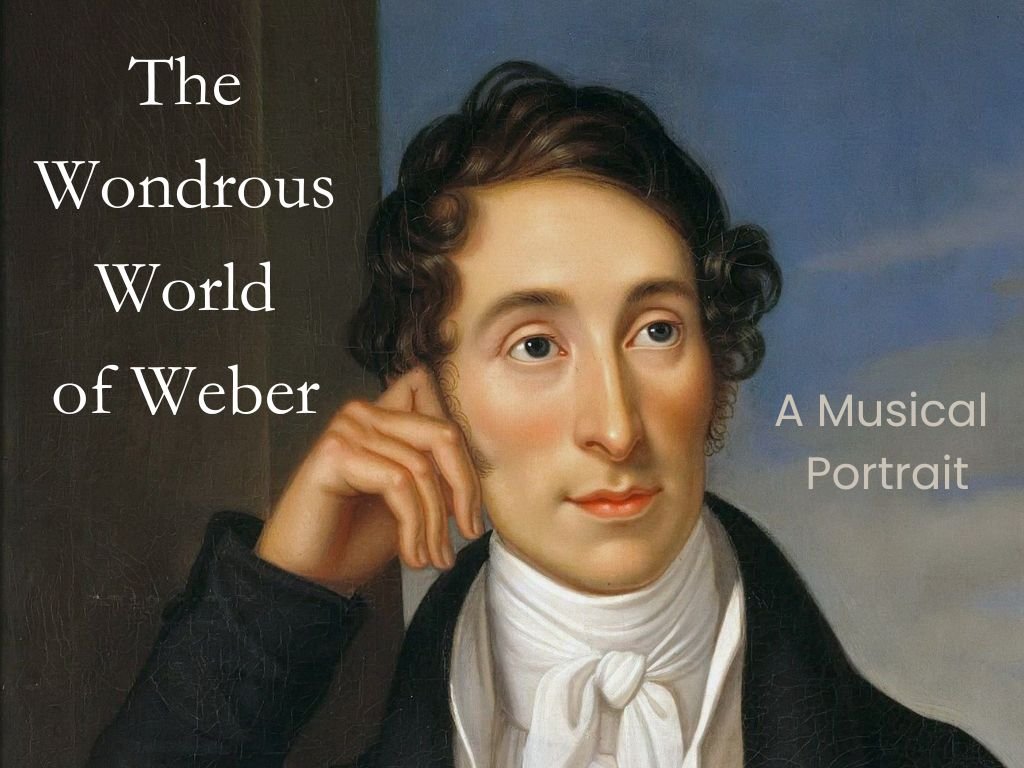with special guest artist
Guitarist Stephen Lochbaum
present
Salón Español
Spanish Chamber Music from the Enlightenment
Saturday, October 20, 2024
St. Noel Catholic Church
Sunday, October 21
The Bath Church, UCC
Program
Trio I from
Trois Trios Pour Guitarre, Violon et Basse, Œuvre 1er (Paris, 1789)
I. Moderato
II. Rondo Presto
Antonio Ximénez Brufal
(1751-1826)
Quartetto III from
Six Quartettos for Two Violins,
a Tenor & Bass, Op. III (London, 1782)
I. Allegro maestoso
II. Minuet & Trio
III. Largo
IV. Allegro non molto
Manuel Canales
(1747-1786)
Intermission
Q[u]arteto V from
Seis Quartetos de dos Violines, Viola y Baxo, Obra I.a (Madrid, 1789)
I. Allegro moderato
II. Rondeau Gracioso
Enrique de Ataide y Portugal
(?-before 1815)
Quinteto 1.o from
Six Quintéti Pour 2 Violons, Guitare, Alto & Basse (Madrid, 1799)
I. Allegro moderato
II. Cantabile
III. Minuetto & Trio
IV. Finale allegro assai
Luigi Boccherini
(1743-1805)
Up Next!
The Wondrous World of Weber
A Musical Portrait
Featuring Wit’s Folly’s historical clarinetist, Dominic Giardino
March 2025
Wit’s Folly would like to thank the following for their generous support of this program:
Tony Ward and St Noel Church; Tim Eck, Laura Pulliam, and The Bath Church, UCC; Early Music America, and Sean Ferguson.
We’d be grateful if you’d take a moment to complete our audience survey.
We promise it’s quick and you’ll also have a chance to subscribe to our email list!
Salón Español Program Notes
When we talk about Classical music, we tend to focus on certain composers and certain places (think Mozart and Vienna, for example) at the expense of the many contributions from the myriad of voices who worked throughout Europe making or patronizing music around the same time. And while the undeniable quality of the music by Haydn and Beethoven deserves our attention, it is easy to lose track of the social structures that made it possible for them to write music, which conditioned how and for whom they wrote it. If you are familiar with our work at Wit’s Folly, this is no news to you, acquainted as you are with names like Eybler, Pleyel, Grétry, Reicha, and events like the French immigration to America in the late 1700s. If this is your first time with us, welcome! We are delighted to share our music with you. It will be a nerdy and wonderful ride. For tonight’s program, we are turning to Spain, a country which many concertgoers do not readily associate with the time period in question, and to its salon culture, which triggered the creation and performance of much chamber music of the time. This salon culture and the people who organized and patronized it are important because they offered composers of the second half of the 18th century a legit avenue where they could distill their finest musical thoughts into the chamber music we love today.
Salons were known in Spain as academias. Hosts, people of means from the aristocracy or the rising bourgeoisie, invited a select group of thinkers, artists, and friends for an evening of conversation, food, and music. These events were an opportunity for the guests to get up to speed with the latest trends, establish new connections (professional or otherwise), and advance their own interests in different ways. Not only could musicians round off their salary, but also show off their skills and potentially find new employers. Hosts, on the other hand, presented themselves as progressive by enabling the free circulation of Enlightened ideas safe from the surveillance of the church or state. As innocent as these gatherings may appear at first, they were not quite so. Some of those ideas were radical in nature, unabashedly critical of the church’s monopoly over truth, or the legitimacy of absolutism as a political system. Many new couples formed, broke up, or were fancied there, prompting furious moralists to lash against the indecency that were at the heart of these academias. One of them described them as “a diabolical invention that, under the pompous guise of civility and entertainment, encourages an infinity of scandals, mistrust, and gossip among the people; it is the ruin of souls, it leads to a total oblivion of God and to a great abhorrence of pious deeds. They are,” he continued, “the bewilderment of the [government] and in them all capital sins take place.” And he had reasons to be scared. The country’s political and ideological fates were discussed there. Institutions like the Royal Spanish and History Academies were born there.
The four works we are playing tonight were conceived and played in these jam sessions of sorts. A wide array of music levels were present, from the revered touring virtuoso to the enthusiast amateur who played as a hobby. The most popular instruments among the attendees were the violin, the flute, the keyboard, and of course the guitar. As the Spanish instrument por excelencia, it represented the national spirit through its quintessential association with a set of popular music genres that would later be known as flamenco. Many plays of the time required guitarists on stage for a fun splash of this music (fandangos, jotas, seguidillas, etc.), which made people go crazy and ensured the show’s success. Coupled with majismo, a trend that romanticized the culture and fashion from Andalusia (the south of Spain) among the upper classes, the guitar had secured a space in all echelons of Spanish society. It is no surprise that an instrument that was the maximum expression of the popular spirit now found itself in the midst of high cosmopolitan gatherings, where it learned how to speak their foreign language.
Antonio Ximénez Brufal was born to a family of musicians in 1751. As an 18-year-old, he joined the music chapel from the Colegiata de San Nicolás in his native Alicante (Valencia), where he worked as teacher and composer as well. To round off his income, he toured as first violin with Teresa Taveggia’s Italian opera company throughout Spain in 1776. The company encountered problems along the way, with some church authorities banning their shows on account of what they considered to be too frivolous of a text. Ximénez, however, achieved fame and the King Carlos III extended him an invitation to join his court for one year. After that, he returned to his post in Alicante, where he remained until his death in 1826.
The state of the press in Spain, archaic, few in number, and burdened with bureaucratic procedures, encouraged many Spanish composers to publish their works elsewhere. Thus, Ximénez published in 1789 his Trios for guitar, violin, and cello in Paris with great acclaim. While the majority of published music hitherto was dedicated to a specific patron, Ximénez dedicated his trios “to the Amateurs.” As such, these are short pieces of easy listening and easy playing for audiences and players to have a good time. This particular kind of merriment proposes a new fashionable ideal of how to be-in-the-world, away from the traditional centers of power that had promoted chamber music in the past. We should remember that in 1789, the French Revolution was about to disenfranchise the aristocracy and change the political landscape in Europe forever in favor of models of self-determination. This is how learned culture infiltrated European cultural heritage despite the collapse of the structures that originated it.
The genre of the string quartet had arrived in Madrid pretty soon after it had established itself in the other European capitals, sometime around the second half of the century. The Italian masters working in Spain like Francesco Corselli and Luigi Boccherini had also produced quartets on Spanish soil, but the honor of being the first Spanish practitioner of the genre would eventually fall on Manuel Canales. We know little about his life, mainly that he was a cellist by trade, educated and later hired by the Toledo Cathedral. In 1770 he moved to Madrid in order to work for the Duke of Alba. Here he was able to work under Boccherini (also a cellist) and to be in contact with a large music library that lacked nothing in comparison to the music hubs of Paris or Amsterdam. By the end of his life, the Duke had amassed a collection of some 1150 music works by composers like Corelli, Geminiani, Rameau, Stamitz, Tartini, Vivaldi, Geminiani, Haydn, etc. The Duke himself was a violinist and owned a fortepiano, 3 violins, 3 violas, a cello, and a bass viol made variously by Stradivari, Guadagnini, Piatellini, as well as Contreras and Ascencio who were the preeminent Spanish makers of the day. Canales dedicated his first set of string quartets (1774) to the Duke. After his patron’s death two years later, Canales tried in vain to get into the royal graces by dedicating his second set of quartets to the King. We will play a work from this latter opus tonight that exemplifies the author’s command of the genre and style, his aptitude for beautiful melodies, and penchant for drama.
Similar in scope to Ximénez’s trio, Enrique Ataide y Portugal’s string quartet is set in two movements in the sunny key of A Major. The author proudly stated his status as a caballero aficionado (‘amateur gentleman’) in the frontispiece of the work. Having served the Spanish military in Cuba and Louisiana, translated several works of Chinese and Greek philosophy from the French into Spanish, and being a published composer, Ataide epitomized what it meant to be an Enlightened man of his times. His string quartets often engage with technical challenges that disavow the notion that amateurs only played “easy” music. Ataide pulls out all the stops in tonight’s quartet by writing high passages on one string, fast string crossings, and even borrowing recitatives from the land of opera. See if you can spot these pyrotechnics in the first movement.
After a period in Vienna and Paris, Luigi Boccherini moved permanently to Spain in 1768. Two years later, he began working for the Infante Luis Antonio, Carlos III’s younger brother. Boccherini thrived under royal patronage until his insolence caught up with him. Fed up after the King had ordered him to change a passage from a piece that he did not like, the composer did not concede and doubled it instead, leading to his own dismissal. He kept serving the Infante, but after his premature death in 1785, Boccherini was unable to procure a job at court, despite being the best cellist in Spain. He found employment for several different aristocrats. One of them was the Marquis of Benavent, an amateur guitarist who commissioned him a set of quintets and a sinfonia concertante with the intention of playing them at the academias he hosted and impress Madrid’s high society. Boccherini accepted but instead of writing new music, he arranged several movements from his piano and string quintets. Little did he know that these pieces would become some of the most appreciated in his output, perfectly balancing local and cosmopolitan styles, and appealing to both professional and amateur players.
— Guillermo Salas-Suárez, October 2024



